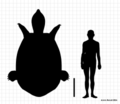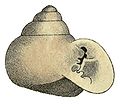Top Qs
Timeline
Chat
Perspective
List of South American animals extinct in the Holocene
From Wikipedia, the free encyclopedia
Remove ads
This is a list of South American animals extinct in the Holocene that covers extinctions from the Holocene epoch, a geologic epoch that began about 11,650 years before present (about 9700 BCE)[A] and continues to the present day.[1]

The list includes animal extinctions in the Falklands and other islands near the continent but not the Galápagos Islands, which has its own list of extinct animals. Extinct animals from the West Indies are covered in List of Antillian and Bermudan animals extinct in the Holocene. Extinctions from Easter Island, a territory of Chile in Polynesia, are covered in the List of Oceanian species extinct in the Holocene.
Many extinction dates are unknown due to a lack of relevant information.
Remove ads
Mammals (class Mammalia)
Opossums (order Didelphimorphia)
Opossums (family Didelphidae)
Possibly extinct
Armadillos, pampatheres, and glyptodonts (order Cingulata)
Long-nosed armadillos (family Dasypodidae)
Chlamyphorid armadillos and glyptodonts (family Chlamyphoridae)
Pachyarmatheres (family Pachyarmatheriidae)
Pampatheres (family Pampatheriidae)
Anteaters and sloths (order Pilosa)
Megalonychid ground sloths (family Megalonychidae)
Giant ground sloths (family Megatheriidae)
Mylodonts (family Mylodontidae)
Scelidotherid ground sloths (family Scelidotheriidae)
Nothrotheriid ground sloths (family Nothrotheriidae)
Elephant-like mammals (order Proboscidea)
Gomphotheres (family Gomphotheriidae)
Rodents (order Rodentia)
Cavies (family Caviidae)
Tuco-tucos (family Ctenomyidae)
Neotropical spiny rats (family Echimyidae)
Rock rats, degus, and viscacha rats (family Octodontidae)
Hamsters, voles, lemmings, muskrats, and New World rats and mice (family Cricetidae)
Possibly extinct
Bats (order Chiroptera)
Leaf-nosed bats (family Phyllostomidae)
Carnivorans (order Carnivora)
Cats (family Felidae)
Dogs (family Canidae)
Bears (family Ursidae)
Earless seals (family Phocidae)
Notoungulates (order Notoungulata)
Toxodonts (family Toxodontidae)
Litopterns (order Litopterna)
Macrauchenids (family Macraucheniidae)
Proterotheriids (family Proterotheriidae)
Odd-toed ungulates (order Perissodactyla)
Horses and allies (family Equidae)
Even-toed ungulates (order Artiodactyla)
Camels and llamas (family Camelidae)
Locally extinct
True deer (family Cervidae)
Remove ads
Birds (class Aves)
Landfowl (order Galliformes)
Chachalacas, guans, and curassows (family Cracidae)
Extinct in the wild
Waterfowl (order Anseriformes)
Ducks, geese, and swans (family Anatidae)
Grebes (order Podicipediformes)
Grebes (family Podicipedidae)
Nightjars (order Caprimulgiformes)
Typical nightjars (family Caprimulgidae)
Possibly extinct
Swifts, treeswifts, and hummingbirds (order Apodiformes)
Hummingbirds (family Trochillidae)
Possibly extinct
Rails and cranes (order Gruiformes)
Rails (family Rallidae)
Shorebirds (order Charadriiformes)
Sandpipers (family Scolopacidae)
Possibly extinct
Storks and allies (order Ciconiiformes)
Storks (family Ciconiidae)
New World vultures (order Cathartiformes)
New World vultures and condors (family Cathartidae)
Owls (order Strigiformes)
True owls (family Strigidae)
Possibly extinct
Parrots (order Psittaciformes)
Holotropical parrots (family Psittacidae)
Possibly extinct
Extinct in the wild
Perching birds (order Passeriformes)
Antpittas (family Grallariidae)
Possibly extinct
Ovenbirds (family Furnariidae)
Antbirds (family Thamnophilidae)
Possibly extinct
Remove ads
Reptiles (class Reptilia)
Turtles and tortoises (order Testudines)
Big-headed turtles (family Podocnemididae)
Amphibians (class Amphibia)
Frogs (order Anura)
True toads (family Bufonidae)
Possibly extinct
Tree frogs and allies (family Hylidae)
Darwin's frogs (family Rhinodermatidae)
Possibly extinct
Rain frogs (family Strabomantidae)
Possibly extinct
Remove ads
Ray-finned fish (class Actinopterygii)
Catfishes (order Siluriformes)
Pencil catfishes (family Trichomycteridae)
Possibly extinct
Toothcarps (order Cyprinodontiformes)
Pupfishes (family Cyprinodontidae)
Possibly extinct
Remove ads
Insects (class Insecta)
Beetles (order Coleoptera)
Predaceous diving beetles (family Dytiscidae)
Bark lice, book lice, and parasitic lice (order Psocodea)
Bird body lice (family Menoponidae)
Possibly extinct
Bird chewing lice (family Philopteridae)
Possibly extinct
Remove ads
Arachnids (class Arachnida)
Order Mesostigmata
Family Halarachnidae
Clitellates (class Clitellata)
Order Opisthopora
Family Glossoscolecidae
Possibly extinct
Slugs and snails (class Gastropoda)
Order Littorinimorpha
Family Cochliopidae
Order Stylommatophora
Family Odontostomidae
Family Strophocheilidae
Unassigned order
Family Hemisinidae
Extinct in the wild
See also
Notes
- Hippidion principale was included within H. saldiasi by Der Sarkissian et al. (2015).[47]
References
External links
Wikiwand - on
Seamless Wikipedia browsing. On steroids.
Remove ads

























































